Comprehensive Welfare Plan: Addressing Needs of Disabled Individuals
VerifiedAdded on 2023/01/17
|5
|1505
|75
Report
AI Summary
This report provides a comprehensive overview of welfare services designed to support individuals with disabilities. It begins with an introduction to developmental disabilities and the importance of coordinated services, emphasizing the role of organizations in ensuring participation and access to community programs. The report then delves into specific welfare benefits, including Personal Independence Payment, Employment Allowance, Carer’s Allowance, and Disabled Facility Grants, detailing eligibility criteria and their impact. It also addresses the Welfare Gains Cap and its implications. A critical evaluation of the adequacy of these benefits follows, highlighting the challenges of sustaining a reasonable standard of living. The report concludes by advocating for increased benefit rates and addresses the challenges faced by disabled individuals, emphasizing the need for financial support to meet basic needs. The report is based on a case study of a disabled individual named Clara and evaluates welfare support for her. References from various academic journals are provided to support the analysis.
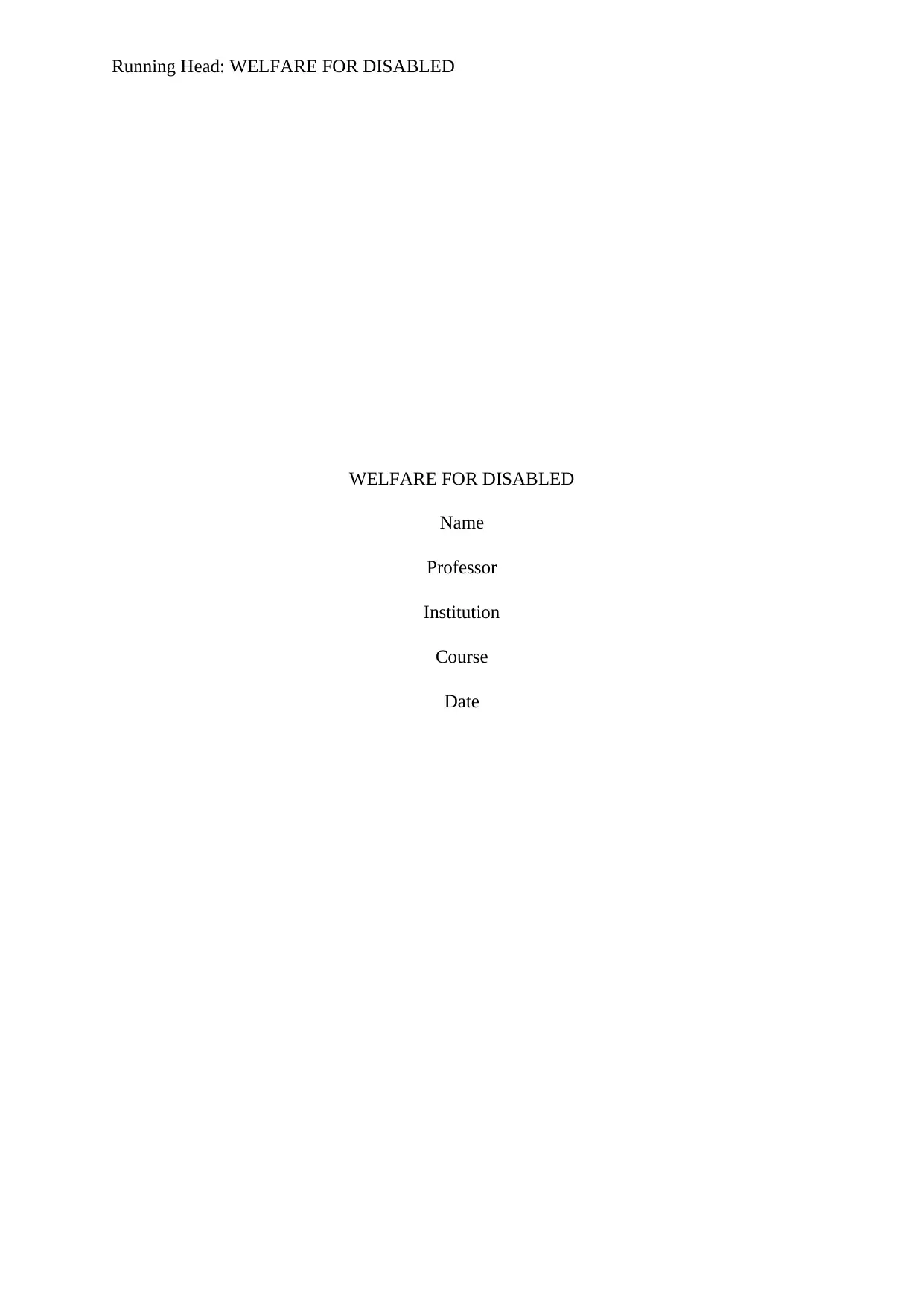
Running Head: WELFARE FOR DISABLED
WELFARE FOR DISABLED
Name
Professor
Institution
Course
Date
WELFARE FOR DISABLED
Name
Professor
Institution
Course
Date
Paraphrase This Document
Need a fresh take? Get an instant paraphrase of this document with our AI Paraphraser
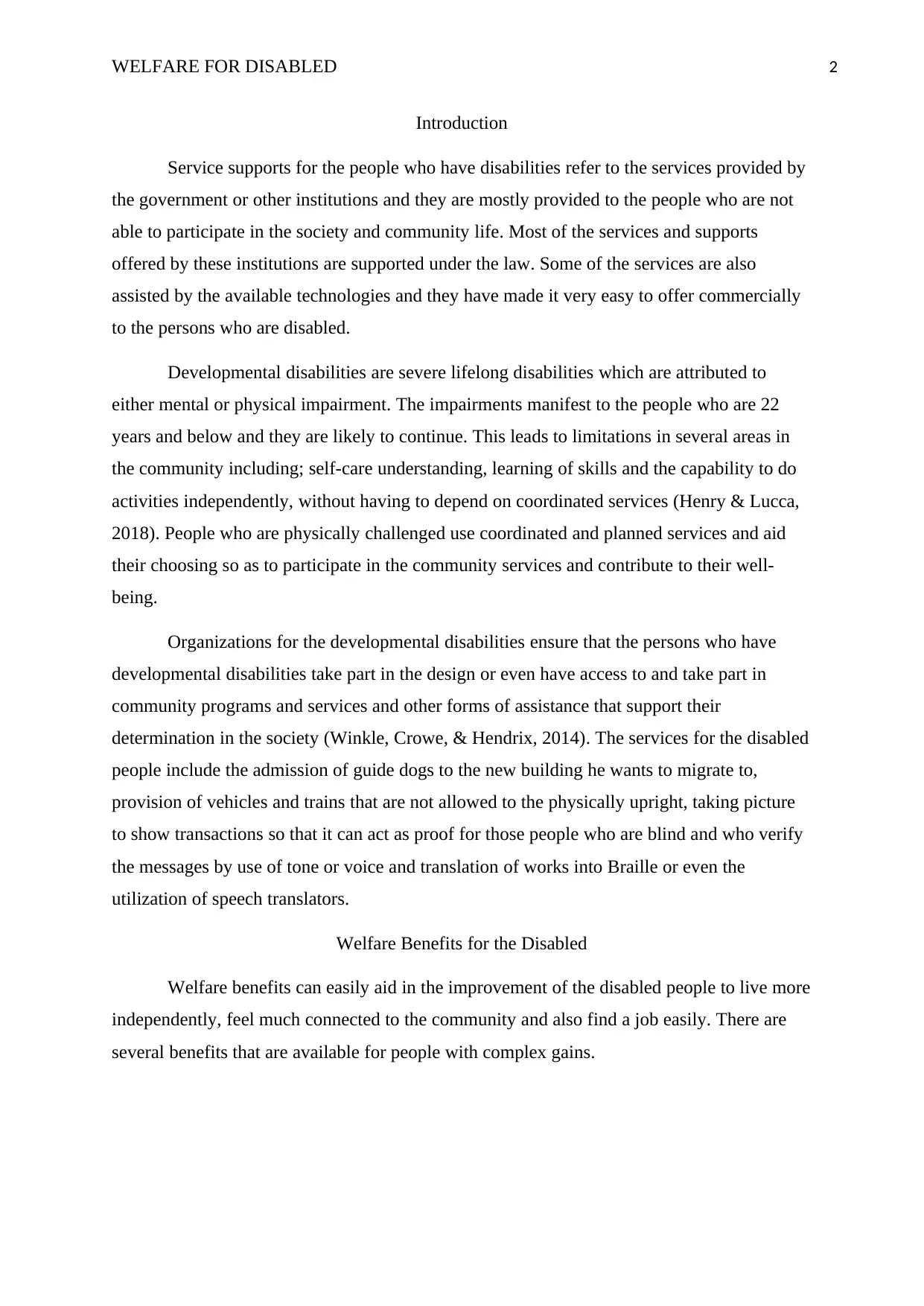
WELFARE FOR DISABLED 2
Introduction
Service supports for the people who have disabilities refer to the services provided by
the government or other institutions and they are mostly provided to the people who are not
able to participate in the society and community life. Most of the services and supports
offered by these institutions are supported under the law. Some of the services are also
assisted by the available technologies and they have made it very easy to offer commercially
to the persons who are disabled.
Developmental disabilities are severe lifelong disabilities which are attributed to
either mental or physical impairment. The impairments manifest to the people who are 22
years and below and they are likely to continue. This leads to limitations in several areas in
the community including; self-care understanding, learning of skills and the capability to do
activities independently, without having to depend on coordinated services (Henry & Lucca,
2018). People who are physically challenged use coordinated and planned services and aid
their choosing so as to participate in the community services and contribute to their well-
being.
Organizations for the developmental disabilities ensure that the persons who have
developmental disabilities take part in the design or even have access to and take part in
community programs and services and other forms of assistance that support their
determination in the society (Winkle, Crowe, & Hendrix, 2014). The services for the disabled
people include the admission of guide dogs to the new building he wants to migrate to,
provision of vehicles and trains that are not allowed to the physically upright, taking picture
to show transactions so that it can act as proof for those people who are blind and who verify
the messages by use of tone or voice and translation of works into Braille or even the
utilization of speech translators.
Welfare Benefits for the Disabled
Welfare benefits can easily aid in the improvement of the disabled people to live more
independently, feel much connected to the community and also find a job easily. There are
several benefits that are available for people with complex gains.
Introduction
Service supports for the people who have disabilities refer to the services provided by
the government or other institutions and they are mostly provided to the people who are not
able to participate in the society and community life. Most of the services and supports
offered by these institutions are supported under the law. Some of the services are also
assisted by the available technologies and they have made it very easy to offer commercially
to the persons who are disabled.
Developmental disabilities are severe lifelong disabilities which are attributed to
either mental or physical impairment. The impairments manifest to the people who are 22
years and below and they are likely to continue. This leads to limitations in several areas in
the community including; self-care understanding, learning of skills and the capability to do
activities independently, without having to depend on coordinated services (Henry & Lucca,
2018). People who are physically challenged use coordinated and planned services and aid
their choosing so as to participate in the community services and contribute to their well-
being.
Organizations for the developmental disabilities ensure that the persons who have
developmental disabilities take part in the design or even have access to and take part in
community programs and services and other forms of assistance that support their
determination in the society (Winkle, Crowe, & Hendrix, 2014). The services for the disabled
people include the admission of guide dogs to the new building he wants to migrate to,
provision of vehicles and trains that are not allowed to the physically upright, taking picture
to show transactions so that it can act as proof for those people who are blind and who verify
the messages by use of tone or voice and translation of works into Braille or even the
utilization of speech translators.
Welfare Benefits for the Disabled
Welfare benefits can easily aid in the improvement of the disabled people to live more
independently, feel much connected to the community and also find a job easily. There are
several benefits that are available for people with complex gains.
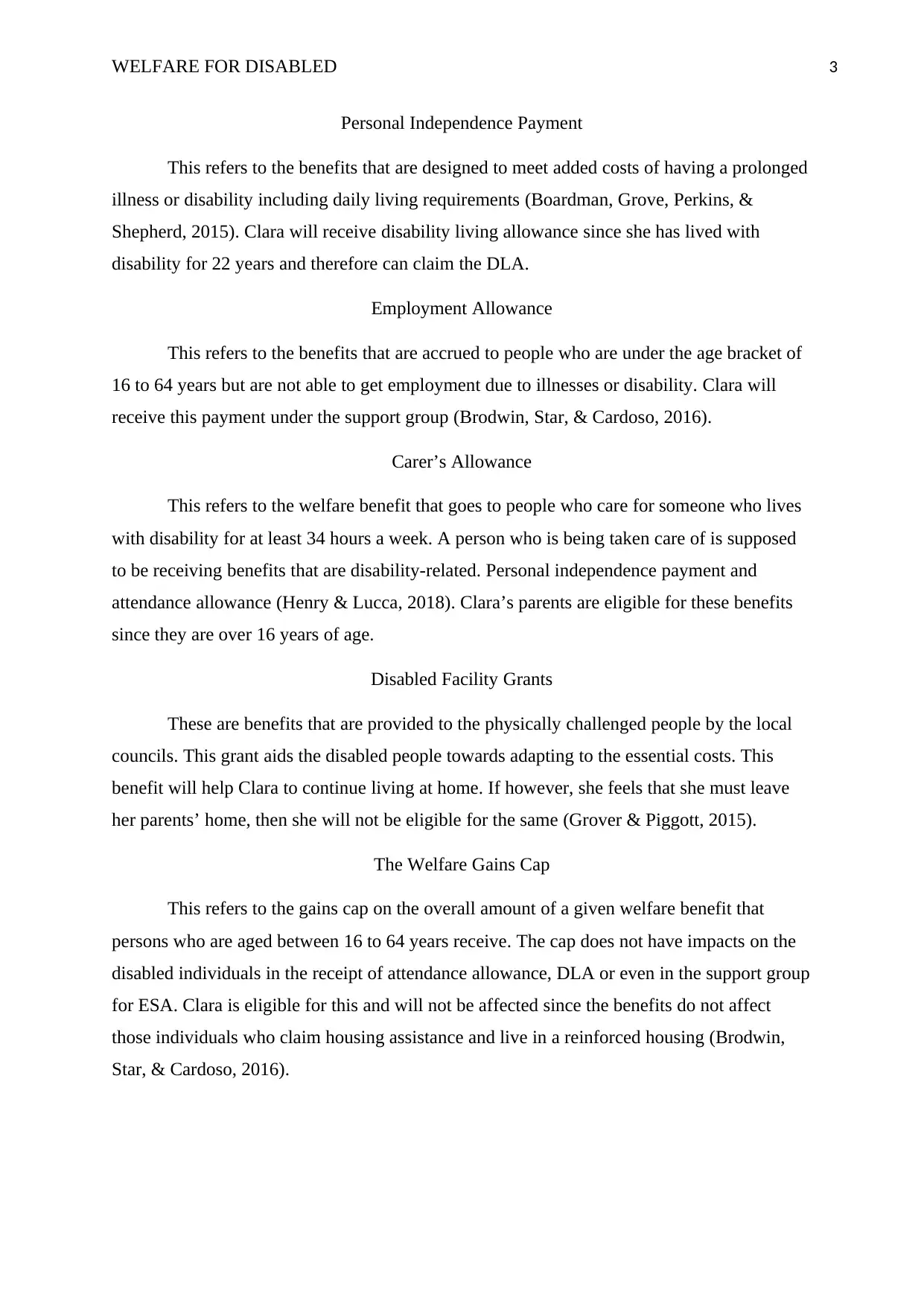
WELFARE FOR DISABLED 3
Personal Independence Payment
This refers to the benefits that are designed to meet added costs of having a prolonged
illness or disability including daily living requirements (Boardman, Grove, Perkins, &
Shepherd, 2015). Clara will receive disability living allowance since she has lived with
disability for 22 years and therefore can claim the DLA.
Employment Allowance
This refers to the benefits that are accrued to people who are under the age bracket of
16 to 64 years but are not able to get employment due to illnesses or disability. Clara will
receive this payment under the support group (Brodwin, Star, & Cardoso, 2016).
Carer’s Allowance
This refers to the welfare benefit that goes to people who care for someone who lives
with disability for at least 34 hours a week. A person who is being taken care of is supposed
to be receiving benefits that are disability-related. Personal independence payment and
attendance allowance (Henry & Lucca, 2018). Clara’s parents are eligible for these benefits
since they are over 16 years of age.
Disabled Facility Grants
These are benefits that are provided to the physically challenged people by the local
councils. This grant aids the disabled people towards adapting to the essential costs. This
benefit will help Clara to continue living at home. If however, she feels that she must leave
her parents’ home, then she will not be eligible for the same (Grover & Piggott, 2015).
The Welfare Gains Cap
This refers to the gains cap on the overall amount of a given welfare benefit that
persons who are aged between 16 to 64 years receive. The cap does not have impacts on the
disabled individuals in the receipt of attendance allowance, DLA or even in the support group
for ESA. Clara is eligible for this and will not be affected since the benefits do not affect
those individuals who claim housing assistance and live in a reinforced housing (Brodwin,
Star, & Cardoso, 2016).
Personal Independence Payment
This refers to the benefits that are designed to meet added costs of having a prolonged
illness or disability including daily living requirements (Boardman, Grove, Perkins, &
Shepherd, 2015). Clara will receive disability living allowance since she has lived with
disability for 22 years and therefore can claim the DLA.
Employment Allowance
This refers to the benefits that are accrued to people who are under the age bracket of
16 to 64 years but are not able to get employment due to illnesses or disability. Clara will
receive this payment under the support group (Brodwin, Star, & Cardoso, 2016).
Carer’s Allowance
This refers to the welfare benefit that goes to people who care for someone who lives
with disability for at least 34 hours a week. A person who is being taken care of is supposed
to be receiving benefits that are disability-related. Personal independence payment and
attendance allowance (Henry & Lucca, 2018). Clara’s parents are eligible for these benefits
since they are over 16 years of age.
Disabled Facility Grants
These are benefits that are provided to the physically challenged people by the local
councils. This grant aids the disabled people towards adapting to the essential costs. This
benefit will help Clara to continue living at home. If however, she feels that she must leave
her parents’ home, then she will not be eligible for the same (Grover & Piggott, 2015).
The Welfare Gains Cap
This refers to the gains cap on the overall amount of a given welfare benefit that
persons who are aged between 16 to 64 years receive. The cap does not have impacts on the
disabled individuals in the receipt of attendance allowance, DLA or even in the support group
for ESA. Clara is eligible for this and will not be affected since the benefits do not affect
those individuals who claim housing assistance and live in a reinforced housing (Brodwin,
Star, & Cardoso, 2016).
⊘ This is a preview!⊘
Do you want full access?
Subscribe today to unlock all pages.

Trusted by 1+ million students worldwide
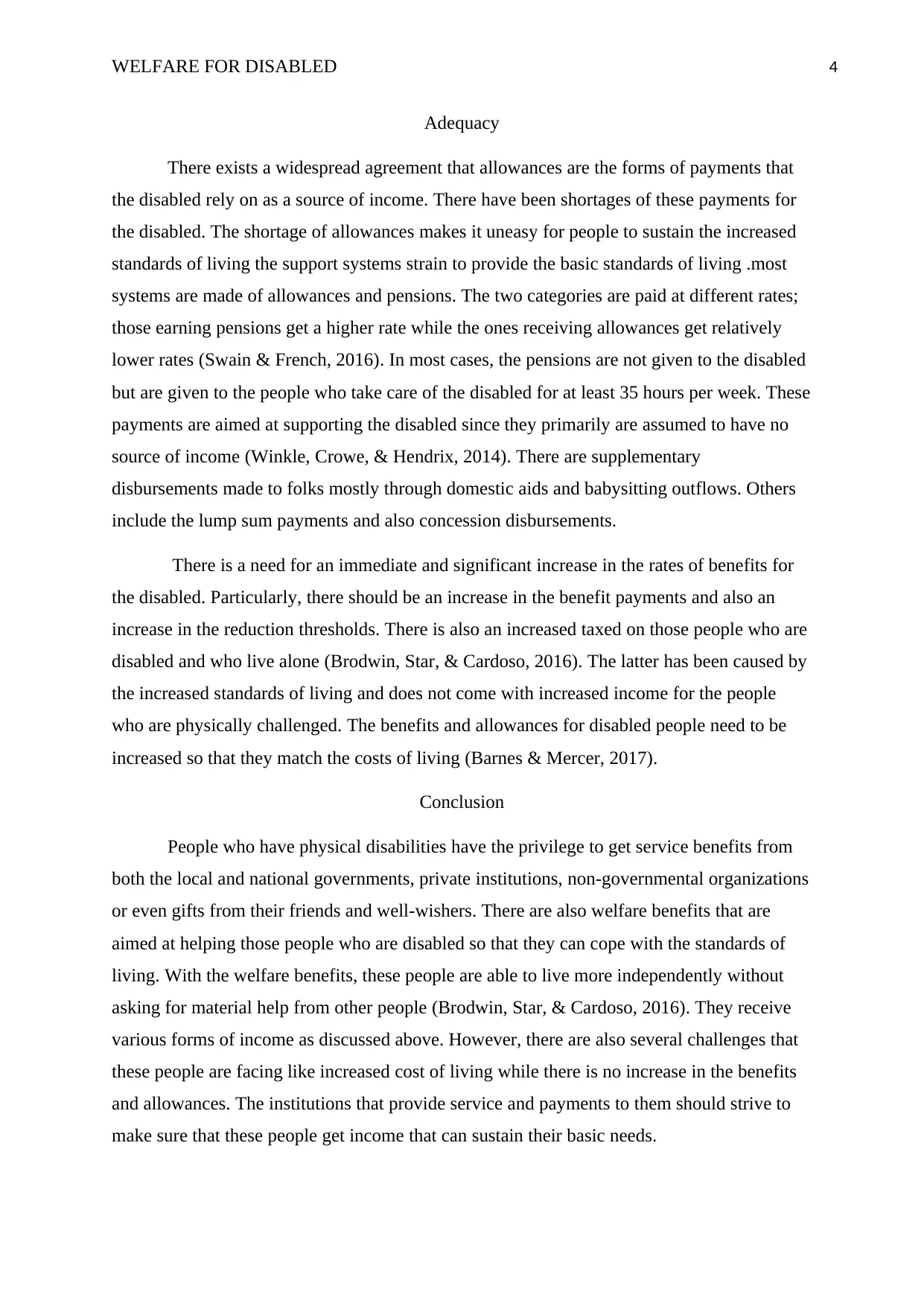
WELFARE FOR DISABLED 4
Adequacy
There exists a widespread agreement that allowances are the forms of payments that
the disabled rely on as a source of income. There have been shortages of these payments for
the disabled. The shortage of allowances makes it uneasy for people to sustain the increased
standards of living the support systems strain to provide the basic standards of living .most
systems are made of allowances and pensions. The two categories are paid at different rates;
those earning pensions get a higher rate while the ones receiving allowances get relatively
lower rates (Swain & French, 2016). In most cases, the pensions are not given to the disabled
but are given to the people who take care of the disabled for at least 35 hours per week. These
payments are aimed at supporting the disabled since they primarily are assumed to have no
source of income (Winkle, Crowe, & Hendrix, 2014). There are supplementary
disbursements made to folks mostly through domestic aids and babysitting outflows. Others
include the lump sum payments and also concession disbursements.
There is a need for an immediate and significant increase in the rates of benefits for
the disabled. Particularly, there should be an increase in the benefit payments and also an
increase in the reduction thresholds. There is also an increased taxed on those people who are
disabled and who live alone (Brodwin, Star, & Cardoso, 2016). The latter has been caused by
the increased standards of living and does not come with increased income for the people
who are physically challenged. The benefits and allowances for disabled people need to be
increased so that they match the costs of living (Barnes & Mercer, 2017).
Conclusion
People who have physical disabilities have the privilege to get service benefits from
both the local and national governments, private institutions, non-governmental organizations
or even gifts from their friends and well-wishers. There are also welfare benefits that are
aimed at helping those people who are disabled so that they can cope with the standards of
living. With the welfare benefits, these people are able to live more independently without
asking for material help from other people (Brodwin, Star, & Cardoso, 2016). They receive
various forms of income as discussed above. However, there are also several challenges that
these people are facing like increased cost of living while there is no increase in the benefits
and allowances. The institutions that provide service and payments to them should strive to
make sure that these people get income that can sustain their basic needs.
Adequacy
There exists a widespread agreement that allowances are the forms of payments that
the disabled rely on as a source of income. There have been shortages of these payments for
the disabled. The shortage of allowances makes it uneasy for people to sustain the increased
standards of living the support systems strain to provide the basic standards of living .most
systems are made of allowances and pensions. The two categories are paid at different rates;
those earning pensions get a higher rate while the ones receiving allowances get relatively
lower rates (Swain & French, 2016). In most cases, the pensions are not given to the disabled
but are given to the people who take care of the disabled for at least 35 hours per week. These
payments are aimed at supporting the disabled since they primarily are assumed to have no
source of income (Winkle, Crowe, & Hendrix, 2014). There are supplementary
disbursements made to folks mostly through domestic aids and babysitting outflows. Others
include the lump sum payments and also concession disbursements.
There is a need for an immediate and significant increase in the rates of benefits for
the disabled. Particularly, there should be an increase in the benefit payments and also an
increase in the reduction thresholds. There is also an increased taxed on those people who are
disabled and who live alone (Brodwin, Star, & Cardoso, 2016). The latter has been caused by
the increased standards of living and does not come with increased income for the people
who are physically challenged. The benefits and allowances for disabled people need to be
increased so that they match the costs of living (Barnes & Mercer, 2017).
Conclusion
People who have physical disabilities have the privilege to get service benefits from
both the local and national governments, private institutions, non-governmental organizations
or even gifts from their friends and well-wishers. There are also welfare benefits that are
aimed at helping those people who are disabled so that they can cope with the standards of
living. With the welfare benefits, these people are able to live more independently without
asking for material help from other people (Brodwin, Star, & Cardoso, 2016). They receive
various forms of income as discussed above. However, there are also several challenges that
these people are facing like increased cost of living while there is no increase in the benefits
and allowances. The institutions that provide service and payments to them should strive to
make sure that these people get income that can sustain their basic needs.
Paraphrase This Document
Need a fresh take? Get an instant paraphrase of this document with our AI Paraphraser
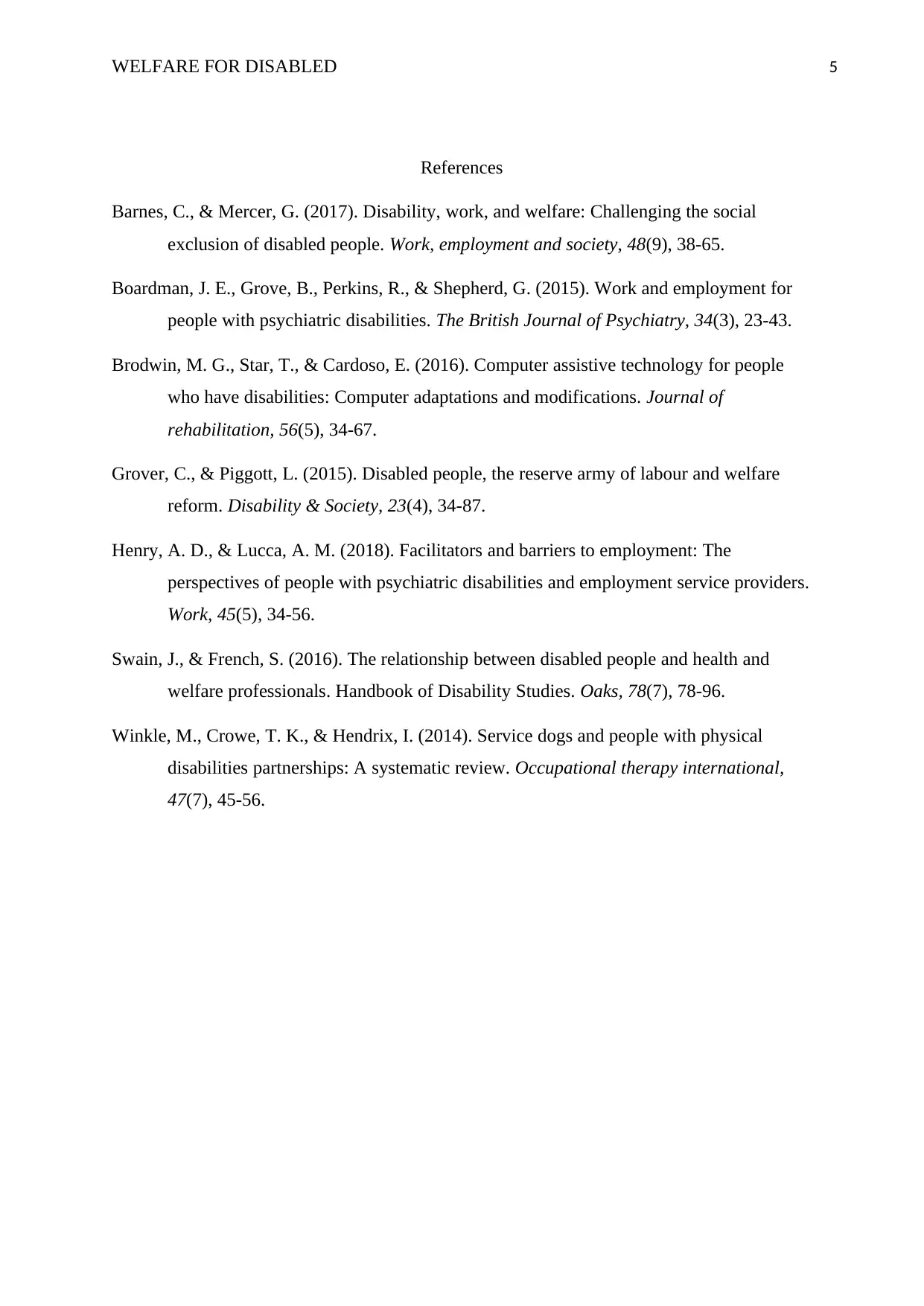
WELFARE FOR DISABLED 5
References
Barnes, C., & Mercer, G. (2017). Disability, work, and welfare: Challenging the social
exclusion of disabled people. Work, employment and society, 48(9), 38-65.
Boardman, J. E., Grove, B., Perkins, R., & Shepherd, G. (2015). Work and employment for
people with psychiatric disabilities. The British Journal of Psychiatry, 34(3), 23-43.
Brodwin, M. G., Star, T., & Cardoso, E. (2016). Computer assistive technology for people
who have disabilities: Computer adaptations and modifications. Journal of
rehabilitation, 56(5), 34-67.
Grover, C., & Piggott, L. (2015). Disabled people, the reserve army of labour and welfare
reform. Disability & Society, 23(4), 34-87.
Henry, A. D., & Lucca, A. M. (2018). Facilitators and barriers to employment: The
perspectives of people with psychiatric disabilities and employment service providers.
Work, 45(5), 34-56.
Swain, J., & French, S. (2016). The relationship between disabled people and health and
welfare professionals. Handbook of Disability Studies. Oaks, 78(7), 78-96.
Winkle, M., Crowe, T. K., & Hendrix, I. (2014). Service dogs and people with physical
disabilities partnerships: A systematic review. Occupational therapy international,
47(7), 45-56.
References
Barnes, C., & Mercer, G. (2017). Disability, work, and welfare: Challenging the social
exclusion of disabled people. Work, employment and society, 48(9), 38-65.
Boardman, J. E., Grove, B., Perkins, R., & Shepherd, G. (2015). Work and employment for
people with psychiatric disabilities. The British Journal of Psychiatry, 34(3), 23-43.
Brodwin, M. G., Star, T., & Cardoso, E. (2016). Computer assistive technology for people
who have disabilities: Computer adaptations and modifications. Journal of
rehabilitation, 56(5), 34-67.
Grover, C., & Piggott, L. (2015). Disabled people, the reserve army of labour and welfare
reform. Disability & Society, 23(4), 34-87.
Henry, A. D., & Lucca, A. M. (2018). Facilitators and barriers to employment: The
perspectives of people with psychiatric disabilities and employment service providers.
Work, 45(5), 34-56.
Swain, J., & French, S. (2016). The relationship between disabled people and health and
welfare professionals. Handbook of Disability Studies. Oaks, 78(7), 78-96.
Winkle, M., Crowe, T. K., & Hendrix, I. (2014). Service dogs and people with physical
disabilities partnerships: A systematic review. Occupational therapy international,
47(7), 45-56.
1 out of 5
Related Documents
Your All-in-One AI-Powered Toolkit for Academic Success.
+13062052269
info@desklib.com
Available 24*7 on WhatsApp / Email
![[object Object]](/_next/static/media/star-bottom.7253800d.svg)
Unlock your academic potential
Copyright © 2020–2025 A2Z Services. All Rights Reserved. Developed and managed by ZUCOL.





